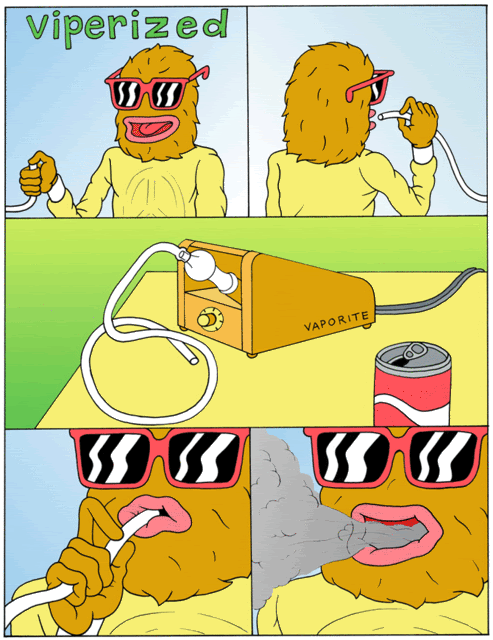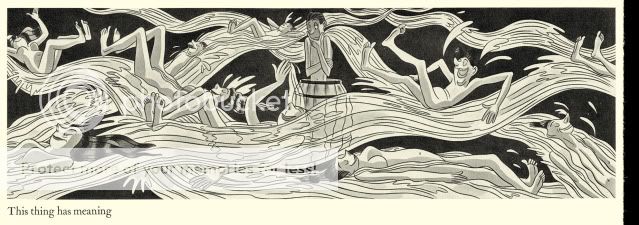Archive for March 31, 2010
Carnival of souls
March 31, 2010* A gigantic Jack Kirby art exhibition curated by Dan Nadel and Paul Gravett? Sure, I’ll eat it! Or I would if it weren’t in Italy. Love the dig at that MoCCA Archie show, too.
* New trailer for The Expendables! Good gravy. I’m actually a little upset that my brother is getting married the weekend this and Scott Pilgrim come out.
* I’m not sure if anything fills me with the joy of my film-student days like a good Gregg Toland/Orson Welles deep-focus shot from Citizen Kane. David Bordwell traces the technique’s antecedents and parallels.
* Zak Smith is trash-talkin’ Tolkien a bit too much for my taste in his post on the H section of the D&D Monster Manual, but the Hell Hound entry makes up for it.
* I like the way Todd VanDerWerff has become my “food taster” for the opinions (usually negative) of Lost fandom at large–he bravely samples them and makes me aware of their overall flavor, and I am free to push away from the table.
Lost thoughts
March 30, 2010SPOILER ALERT, SPOILER ALERT
* Historically, I’d come to dread Jin/Sun episodes of Lost. They were to me what Kate episodes or “FlashJacks” were to a lot of other people. Yes yes, they’ve had a troubled relationship marred by deceit, we get it. Things necessarily livened up once the flashbacks gave way to flashforwards, the Islanders/Oceanic Six split, and time jumps. But since I knew that this season’s Jin/Sun episode would be showing us what the couple was up to in 2004, flashback style, I really wasn’t looking forward to it at all. Not even knowing that Jin would end up bound and gagged in a gangster’s kitchen someplace did much to sweeten the pot.
* But whaddyaknow, it was a good episode!
* For one thing, it turns out that Jin ending up bound and gagged in a gangster’s kitchen someplace sweetens the pot quite a bit. The flashsideways couldn’t end with some little epiphany about their relationship, it had to end with how Jin escaped from his plight. The relationship stuff was sort of seeded throughout, and came off the better for it. And hey, it’s still all based on lies, but this time it’s a mutual lie rather than one lying to the other. It’s not quite the breakthrough achieved by Jack, Ben, Locke, or Sawyer, but it beats poor Sayid.
* Also, it wasn’t the worst idea in the world to kick off the Jin/Sun stuff by having Sun take her top off. I’m just sayin’.
* But beyond that, it gave Sun something to do! I wasn’t super-into her heel turn during the flashforwards when she was plotting to kill Ben, but as the Missus always puts it, she’s not a person you wanna fuck with. I like that she’s normally sweet but very dangerous when cornered or pressured. She’s her father’s daughter.
* Another thing the episode had going for it was that it appears we’ll be advancing the main Island mythology ball at a pretty rapid clip at this point, or at the very least eliminating some possibilities as to what the heck’s going on. For example, between Fake Locke’s bug-eyed distress upon finding his camp raided in his absence–and surely all of us thought he’d left on purpose!–and the dick-measuring contest he had with Widmore on the shore of Hydra Island, we can now rest assured that they really aren’t on the same side.
* This raises the question: If Widmore and his people want to stop the Monster, and Ben and his Others worked (after a fashion) for Jacob who also wanted to stop the Monster, then we really were looking at a blue-on-blue conflict, if you will: Two rival teams of “good guys” who were doing horrible stuff all the time to one another and to anyone else who got in the way. “Good guys” really deserves its sneer quotes on this show.
* Also, our Cavalcade of Unreliable Narrators with regards to explaining the Monster/MIB/Fake Locke saw the addition of Charles Widmore. Welcome aboard, Chuck! Now in addition to Richard’s warning that he’d kill everyone on the Island and everyone everyone on the Island cares about, and in addition to Jacob’s characterization of the MIB as a darkness that can’t be allowed to spread past the Island, and in addition to the late Isabella’s warning (via Hurley) that if the MIB escapes “we all go to Hell,” Widmore says that should the MIB get off the Island, Sun and Ji-Yeon and Penny and presumably many more people besides will “cease to exist.” !!! What is this guy, Azathoth?
* And then there’s Fake Locke himself, explaining that he needs all the remaining Candidates to get off the Island. Apparently they have to come willingly, since otherwise he could have just Smoke Monstered Sun’s ass to wherever he needed her to be. Jack and Hurley too, for that matter.
* Kate’s not listed on the wall of the cave “anymore.” She used to be–what changed?
* Great bit with Sayid not feeling anything. I was curious as to how Fake Locke would react to that–was this a surprise to him, or something he’s seen before, or at least expected? Seems like he was unfazed, for whatever that’s worth.
* I’m quite glad Kevin Durand was back again as Martin Keamy. How creepy! I do wish Andrew Divoff had been given more to do as this new, two-eyed, more mild-mannered, easier to kill Mikhail Bakunin, however. And it was also a bit weird to see an Other mixed up with Keamy’s crew–almost a stretch, I’d say.
* Speaking of which, I’m waxing enthusiastic for this episode despite my hunch that Internet naysayers will have a field day with this one. Sun’s loss of English (followed by the now de rigeur fanservice acknowledgement by Frank–could have been Hurley or Miles or even Sawyer too–that this is kind of ridiculous), Jack’s line about the tomato that didn’t know it was supposed to die, Mikhail getting shot in the eye OMG!!!, Jack once again earning someone’s trust for a big plan despite the fact that all his previous plans ended in bloody disaster, a SWAT team led by a geophysicist and that dimpy guy from various commercials taking out a few dozen hardened Others and Castaways with poison darts…a lot of the stuff in this episode could read as clunky or cheesy or forced. I just read it as fun.
* One thing about that Jack/Sun conversation: I think it’s worth pointing out that you can trust people for different reasons. Trusting Jack doesn’t necessarily mean that you have confidence in his ability to successfully execute a plan, it just means that you trust he’s a good person with your best interests at heart. Frankly, I too would take that over a smoke monster wearing the skin of my crazy dead friend.
* Was I disappointed that it was Desmond in the locked room, not Walt? You betcha. I mean, I guess I ought to have known that the guy in the opening credits in every episode would show up by now. Oh well. Still holding out hope that Walt is 108.
* Oh yeah: What the heck can Desmond do to stop the MIB? We’ve seen that he has some rare abilities in terms of weathering time travel of various kinds, and he managed to blow the Hatch without imploding…
Carnival of souls
March 30, 2010* Last night I saw the stage adaptation of The Diary of a Teenage Girl by Phoebe Gloeckner. It was great. Here’s my review. But I really want to stress that the show is accompanied by an exhibition of original Gloeckner art and comics pages, which right then and there transforms it into a can’t-miss situation for fans of Gloeckner’s work. I mean, these things are astonishing. The show runs through MoCCA weekend, so get your tickets, and even if you hate the play or think it’s just alright, you’ll have seen Gloeckner originals up close and personal. The blowjob cross-section, for God’s sake. The beach scene!
* Elsewhere on Robot 6: Bill Sienkiewicz draws friendly dictators.
* The Bram Stoker Awards will recognize graphic novels. That’s cool, but only if they look farther afield than the schlocky, not scary horror-comics mainstream. I mean, I’m totally fine with two nominations being eaten up by The Walking Dead and Mike Mignola every year, but I’d rather see The Squirrel Machine instead of Simon Dark or whatever.
* I enjoyed this essay by Oscar Moralde on the challenge of ending a TV series for The House Next Door. I think he’s right that Lost‘s finale, by virtue of the whole construction of the series, will bear more weight than even the finales of The Sopranos and Battlestar Galactica, for good or ill.
* They’re remaking Godzilla–yes, again. I’m mildly optimistic. It’s a little-known fact that I freaking LOVED Godzilla as a kid, and I would assume that the hideous Devlin-Emmerich remake provides a pretty convenient “what NOT to do” guide for whoever makes the new one. Cloverfield proved how scary scale can be; I imagine a Hollywood Godzilla is going to be an all-ages summer-tentpole affair rather than a serious horror movie, but summer-tentpole needn’t equal braindead.
* I think I love you, Zak Smith.
* I think I hate you, Ken Bromberg.
* Lost thoughts tonight, of course, but for now why not take one last gander at last week’s?
Comics Time: The Diary of a Teenage Girl
March 30, 2010 The Diary of a Teenage Girl
The Diary of a Teenage Girl
Phoebe Gloeckner, writer/artist
Frog, Ltd., 2002
312 pages
$22.95
Buy it from Random House
Buy it from Amazon.com
Originally posted at The Savage Critics on April 27, 2009.
Heartbreak and rage: that’s what I feel when I read this book. It’s the story of one Minnie Goetze, a 15-year-old girl growing up in ’70s San Francisco, doing so in large part by having sex with her alcoholic mother’s adult boyfriend and, as time goes by, through various other increasingly drug-fueled sexual encounters. There are a couple of tricks to the book.
The first is that “Minnie Goetze” is Phoebe Gloeckner. Gloeckner doesn’t so much deny that the book is autobiographical as question the validity of the very notion of autobiography, but I mean, that’s a photo of teenage Phoebe Gloeckner on the cover, what can I say. Does it matter, more than in just a lurid/tabloid way? I think it does a bit, in that you can then see the book not just as a novelistic chronicle of a precocious teenager’s troubled adolescence but as a product of that adolescence, and of the subsequent lived experience of its author. It also goes a long way toward explaining how perfectly Gloeckner is so able to capture teenagedom’s unique combination of acute self-awareness and total cluelessness, its passion for physical pleasure and mental/emotional inability to process that pleasure’s ramifications: Presumably, a lot of this is lifted from an actual diary of an actual teenage girl.
The second trick is that the book is a hybrid, “An Account in Words and Pictures” as the subtitle puts it. The bulk of the book is prose, a series of entries from the titular diary. That material is the voice of 15-year-old Minnie, pure and simple. Though she frequently addresses an imaginary audience in those entries, they really have an audience of one, Minnie herself, and they’re where you get her unfiltered in-the-moment understanding of what is going on in her life. Then there are doodles and full-fledged, underground-style comics created by 15-year-old Minnie (actually 15-year-old Phoebe) interspersed throughout, revealing how Minnie is processing her experiences into art, just like any artist would. (At 15 she could already draw the pants off a lot of underground cartoonists, by the way).
Next there are illustrations by the grown-up Gloeckner (we never have a sense of the presence of a grown-up “Minnie”), sometimes presented as spot illos, other times receiving a full Victorian-style page with a caption beneath it. Here is where the current, adult author inserts herself, crafting psychologically subjective images of whatever is going in the narrative. Sometimes they’re just impeccably drawn portraits of the characters (“Ricky Ricky Ricky Wasserman, that exquisitely handsome boy”) or doodles of the minutiae and marginalia of Minnie’s life and mental environment (“the image of the dinosaur that is travelling through space right now”). Other times they’re stylized for effect, highlighting the venality and ridiculousness of Minnie’s situation with satirical savagery. A favorite weapon in Gloeckner’s artistic arsenal is to exaggerate the size of Minnie and her teenage friends’ heads in proportion to their body, or exaggerating the size and fleshiness of Monroe, Minnie’s adult lover, in proportion to Minnie–emphasizing the fact that for all her intelligence and sexual experience, Minnie is a child, often with a child’s way of relating to the world. (It’s easy to understand the implication of her near-constant crying before and after liaisons with Monroe, or while there’s just as much of a thematic connection between her sexual and pharmacological voraciousness with her sweet-tooth as there is with the alcoholism and drug use of her mother and Monroe himself.)
Finally there are the comics, which is why I’m talking about this book on this site to begin with. This, again, is adult Gloeckner expressing herself, but this time with the dispassionate yet brutally condemnatory eye of reportage–a Joe Sacco of Polk Street, right down to the formidable chops. (Gloeckner worked as a medical illustrator, which helps explain images like these–“exceptionally unsafe for work,” as the site warns.) Using a couple of simple grid templates and relying on few illustrative tricks except exceptional craft, the comic sequences generally focus not on the truly disturbing moments in her life, the statutory rape and the heroin–for that, see Gloeckner’s first book, the collection A Child’s Life–nor on the girly teenage fun stuff that pops up in the illustrations and prose with just as much frequency as the sordid material. Rather they depict the run-of-the-mill not-right-ness of her everyday life. A mother who parties with a lawyer they’ve nicknamed “Michael Cocaine” in front of Minnie and her sister, though he’d never do so in front of his own kids. A married man Minnie’s friend Kimmie babysits for, getting them high and driving to a hotel to have sex with them. Various men, from family friends to upperclassmen, making comments about Minnie that are just this side of uncomfortable and inappropriate. Minnie’s mischievous antics around Monroe, Monroe’s dismissiveness and emotional unavailability and predation toward Minnie. There’s a bravura, wordless sequence where Monroe takes Minnie and Kimmie to the beach, and as we and Minnie watch, Monroe seduces her friend. Another knockout where Minnie and the girl she falls in love with, Tabatha, smoke a joint that Tabatha then tells Minnie was laced with angel dust, the neat grid of the comic giving way with a page-turn to a midnight-black splash page peppered with psychedelic non sequitur images (the dinosaur travelling through space makes a return appearance), evoking the mystery and terror of chemically blowing a mind that isn’t nearly finished growing on its own.
It’s not easy material, that’s for sure. But it’s warm and detail-driven and just so, so smart, even at its most potentially sensationalistic. And it’s rich, extraordinarily so. The main storyline is devastating, no doubt–this time around reading the book, I found myself getting physically nauseated when Minnie’s diary falls into the wrong hands, the same way I felt when I had a similar experience as a teenager; meanwhile my anger and disgust for Monroe and Minnie’s neglectful (or outwardly abusive, depending on how charitable you feel like being) mother were almost physical as well, as was my delight in reaching the book’s final illustration/caption combo (you’ll enjoy it when you get there, too). But you can just as easily spend a read-through focusing on, say, the contrasting qualities of the illustrated material like I did above. Or the development of Chuck and Pascal, the two characters who genuinely appear to have Minnie’s best interests at heart, and their fates as we learn whether or not that is in fact the case. Or the ’70s countercultural touchstones: David Bowie, Donna Summer, Pink Floyd, EST, Rocky Horror, R. Crumb and His Cheap Suit Serenaders. Or how fearlessly Gloeckner addresses teenage sexuality and sex in general. The raw pleasure, the hunger for it…
Oh God, you know, you can really feel it when they come inside of you.
I know Monroe would miss me if I wasn’t around. I know he’d think about me then because he doens’t know anyone else like me. I think of him all the time.
And that hot breath…dreamy.
And when they’re just as hard as rocks and they’re stabbing you and you could just scream you can hardly breathe it is so 78vghjftgj46z35uzsfyubyuib78cx5742q24xr68v680b790[79[v689pc568ozx3463455yw46uc46759v689pvyuiuilv679
…and the barely suppressed disgust at the physicality of it…
The sexual nature of Kimmie Minter is a viscous cervical mucus that always welcomes mating. She was slimy and wet even though she always says she doesn’t like Monroe and she says Marcus’ dick is much bigger and it’s too bad I didn’t see it.
…and the emotional trauma it can cause when people who should know better have made it so that’s all you see yourself as good for…
I hate men. I hate their sexuality unless they are gay or asexual or somehow different from the men I’ve known. I hate men but I fuck them hard hard hard and thoughtlessly because I hate them so much. At least when they’re fucking me, they’re not looking at me. At least I can close my eyes and just hate them. It’s so difficult to explain.The Diary of a Teenage Girl is, in that sense, the diary of a lot more than one teenage girl. It’s the intimate mind-life of a segment of society populated by men, so very very very many men throughout the book, who sense pain and hunger like that radiating off a 15-year-old and swoop in like moths around a flame, like vultures around a carcass. And for every extraordinarily strong and brilliant and talented Minnie who manages to emerge from the swarm intact enough to recount her experiences decades later, how many don’t? It’s a comic from the edge of the abyss, and I love it.
PS: In case you missed the link, here’s a lengthy interview I conducted with Gloeckner back in 2003. It’s one of my favorite interviews I’ve ever done.
Carnival of souls
March 29, 2010* Recently on Robot 6:
* …and Barack Obama looks at awesome things.
* AMC has picked up six episodes of The Walking Dead, to air around Halloween. I wonder if this covers the first story arc?
* Lost links: Here’s Todd VanDerWerff’s weekend odds’n’sods post and Whitney Matheson’s weekly best-of comment roundup. For my part, I watched the last two episodes back to back with The Missus this weekend and enjoyed both more than I had initially.
* I liked this bit from a Daily Kos post by Devilstower on MMORPGs:
As I was passing through a town, a figure came running up to me. It was another player, a low level player dressed only in rags.
“Can you help me?” he asked. “I’ve just started playing this game, and this player — one not as far along as you — killed me and took all my stuff. He ambushed me right outside of town.”
Being exceeding noble, I followed this poor man back to the scene of the crime. Want to guess what happened next? If you think I managed to kill off the criminal and return the victim’s gear, please come back when Barney is over. If you think that I fought the good fight and the victim and I became online pals, that’s endearing, but no. If you think that as soon as I took ten steps out of town, the “victim’s” half-dozen bruiser pals jumped out of hiding, beat me senseless, and took every scrap of my gear and money now you’re talking. They killed me, jumped up and down on my corpse, and laughed at me.
And the first thing I did was get angry, and the second thing I did was think “wow, this is going to be huge.”
* Chloe Sevigny shit-talks the most recent season of Big Love on the record, claims to have been taken out of context, gets called on it. As a writer, this sort of thing makes me happy, because it’s so easy to blame journalists and reporters and critics and so on for problems of your own making. On the other hand, Sevigny seems not to stand foursquare behind “out of context”–her ultimate explanation is basically “I wish I hadn’t said that.” I can sympathize with that.
* Matthew Perpetua is a one-man army of Goldfrapp. I myself disagree strongly with the lukewarm reviews her last two records have garnered. It’s weird how everyone lined up behind “folk” and dismissed it as such when Seventh Tree was hardly folk, and how Head First is getting dismissed as unmemorable when it’s such a perfect package of a microgenre with an emotional project. (’80s, ’80s, yes, I know, but I don’t recall a lot of people doing stuff with things like the Pointer Sisters and Jefferson Starship and Olivia Newton-John and ELO.) Also, what a live show!
* Finally, I’ve been reciting this sketch for years with no hope of ever actually seeing it again, so imagine my surprise and delight when David Paggi directed my attention to it today. It’s from the Jon Stewart-hosted, The State-starring MTV show You Wrote It, You Watch It, and I love it so. It’s a PAR-ty line, and the party’s goin’ FINE!
Carnival of souls
March 25, 2010* Allow me to be the 3,892nd person to direct you to the trailer for Scott Pilgrim vs. the World. It looks good! I like how the trailer is cut as if to communicate “This ain’t your very slightly older sibling’s Michael Cera movie.”
* Speaking of young people who punch each other while learning about life, check out a giant 50-page preview of my pal Justin Aclin’s new superhero graphic novel Hero House!
* Hey look, that cartoon Grant Morrison was gonna do for Virgin is kind of, sort of, almost coming out! Artist Mukesh Singh did nice work on that Gamekeeper book.
* Recently on Robot 6:
* and Matt Furie Boy’s Club luv.
* Real-Life Horror: The Pope belongs in prison because he supports and enables the molestation of little children, as does the Roman Catholic Church as an institution. (Yes, I went to Catholic high school, why do you ask?)
Carnival of souls
March 24, 2010* Jason Leivian of Floating World Comics interviews Benjamin Marra of Night Business and Gangsta Rap Posse infamy for The Comics Journal. Why is it that Ben’s broad-strokes dismissal of literary comics comes across as charming and sincere while every other “blah blah boring autobio artcomics blah blah blah” person comes across like a giant tool? (Via Traditional Comics.)
* I wish there were a way to subscribe to all of Vice‘s comics-related content in a separate RSS feed, rather than wade through god knows how many pictures of beheaded goats, blood- and feces-stained restrooms, and slatternly drunk people to get to it. As it stands I’ll just click over once and a while and power through to get to the comicsy stuff. For example:
* Here’s one of Nick Gazin’s review rampages, this one featuring photos of topless women for some reason. Featured books include Hot Potatoe, Night Business, City-Hunter, The High Soft Lisp, Almost Silent, The Unwritten, Young Liars and more. As usual it’s written in the voice of your friend’s older brother who wore a lot of denim and listened to Motorhead.
* Here are some jam comics by Gazin and Johnny Ryan. Sample quote: “Ha ha, your shit died of AIDS!”
* Best for last: A new Boy’s Club comic by Matt Furie! Nobody does it better.
* Still at Vice but not comics-related, Chris O’Neill talks to Internet/virtual reality pioneer Jaron Lanier about his Web 2.0 skepticism, as expressed in his book You Are Not a Gadget, which I keep going on about but still haven’t read. Here are a couple of passages that struck me:
As an example, right now there are a lot of software designs that have a tendency to put people in a situation where they happen to get mean. Because people act in an anonymous way, they are without consequences and so aggregate into mob-like tendencies very easily. One example of poor design which brings out the worst in people is the anonymous postings beneath YouTube videos. We’re seeing these specific designs — not the web as a whole — tending to create a profound split where people only talk to their kind, becoming ever more confrontational and ever more dysfunctional. I don’t think such designs are good, they promote meanness and they cause damage on a very significant scale.
I don’t know why I never thought of the Internet’s anonymity-based structure as a conscious choice with the negative repercussions I see every day in Robot 6 comment threads, but there you have it. Lanier also talks about how David Bowie would be impossible today, which is worth noting.
* Jeeeeeesus, has everyone been reading the serialization of What Am I Doing Here? by Abner Dean at What Things Do? Look at this! Please, someone put this back in print.
* Zak Smith’s journey through the Monster Manual has taken him up to G. Sample quote:
Frost giants are extraordinarily metal, and being metal is always good.Interestingly, slaying frost giants is also metal–even more metal than being a frost giant. And therein lies a great insight into the nature of metal.
* I’ll be discussing Todd VanDerWerff’s Lost review/recap at greater length in my own Lost thoughts comment thread, I think, but here it is for now.
Comics Time: The Last Lonely Saturday
March 24, 2010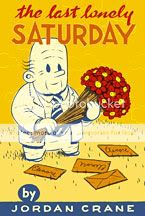
The Last Lonely Saturday
Jordan Crane, writer/artist
Red Ink, 2000
80 pages, hardcover
$8
Buy it from Fantagraphics
Originally published at The Savage Critics on March 16, 2009.
I find it both impossible and undesirable to separate The Last Lonely Saturday from the pivotal role it played in my life as a comics reader, and thus in my life in general. During the year 2001 I took a job as an editor at the A&F Quarterly, Abercrombie & Fitch’s big giant magazine/catalog/softcore porn hybrid publication. My boss there, Savas Abadsidis, was and is a big fanboy, and a chance encounter with a Wizard magazine on his desk, which contained an article teasing an upcoming revamp of the X-Men by Grant Morrison (whom I remembered favorably from my days as a comics reader in high school for Arkham Asylum) and Frank Quitely, led me into Jim Hanley’s Universe on 33rd Street to track down the series. This was the first time I’d entered a comic shop to purchase anything that wasn’t either an isolated Acme Novelty Library, Savage Dragon, or Frank Miller comic in years–the birth of my modern comics readership.
Intrigued by the offerings on hand, and empowered by a complete lack of editorial oversight that enabled us to write about anything we wanted in the Quarterly–not to mention Abercrombie’s expense account–I made a solemn vow to buy something completely unfamiliar to me every week. Jordan Crane’s The Last Lonely Saturday was one of my first such purchases. From there it was a short journey to Crane’s anthology NON, his distributor Highwater Books, the Fort Thunder aesthetic in general, and thence all of alternative comics.
None of that was likely to happen if I didn’t just love The Last Lonely Saturday to pieces. And that itself might seem unlikely. It’s a slight book–many of its 80 pages are endpapers, and the rest contain all of two panels apiece. Dialogue is minimal; the majority of it of it comes from a little boy’s triplet proclamations: “It’s a man,” “Look man run,” “Ha ha! Windy!” It has a simple red, white, and orange color scheme. Although a ghost is involved and a character dies, we’re pretty far from the violent morality plays that make up much of Crane’s recent work.
What The Last Lonely Saturday is is a love story, a romantic fable. To some eyes, it might be a creepy one at that. In the tradition of the Police’s “Every Breath You Take,” albeit in something of a gender reversal from that song, Saturday could be looked at as a depiction of the role fixation and selfishness, even emotional violence, frequently play in love. But just as the sweeping, insistent, intimate, evocative sound of “Every Breath You Take” make it one of the great love songs regardless of the obsessive lyrics, so too the particulars of The Last Lonely Saturday make it pretty much the best love story in comics form I’ve ever come across. Crane’s character designs are at their most adorable here. His jolly little potato-shaped protagonist, with his rumpled suit and charmingly crinkled brow, looks like the grandpa of our collective unconscious made real. His beloved Elenore’s jaunty hairdo, long eyelashes, and high-wattage smile evoke beauty and charm that transcends her cartoony form, while her two lines of flashback dialogue upon receiving flowers from her beau (“Oh sweet heart! They’re just lovely!”) nail me to the floor with sweetness every time. Everything seems airy–leaves and papers float and twirl in the breeze, the little old man’s car jauntily jumps along the road, puffy white clouds are a constant presence in the background–until, at the story’s moment of truth, Crane weighs down his line and crumples his art toward the center of the panel. I’m a huge, huge sucker for emotionally devastated old men, so imagine my utter joy when our hero is granted a reunion with his dear Elenore! (Think the video for Blur’s “Coffee & TV” and you’ve pretty much got it.) At that point, it doesn’t matter to me how it happened–that it did happen is what’s important, and that Elenore understands this is what makes The Last Lonely Saturday a great love story, in that it appreciates that what can seem unpleasant to outsiders is, within that world of two, an act of grace. It’s an intelligent, moving, beautiful, terrific little comic.
Lost thoughts
March 23, 2010¡SPOILERS!
* Alright, I may be done speculating about what the real deal is with Jacob and the Man in Black, what they really want, whether they’re good or evil, whatever. We just have no clue! I mean, I’ve gone on at length about what an enjoyment-sucking waste of time Doc Jensen-style theorizing is, but obviously I’ve still had fun trying to guess what was up with the core mystery. But after tonight’s episode, I’m about ready to hang up my spurs. From tweaking our understanding of how the Monster operates (apparently he can take the form of a dead person and make Smokey noises off) to showing omniscient Jacob as slightly less than omniscient (he seemed surprised enough by Richard to beat him up before asking questions) to showing benevolent Jacob as slightly less than benevolent (lording it over the MIB, being kind of a dick to Richard, his whole sadistic lab-rats experiment of dragging people to this Island to kill each other on the off chance that they might not and thus help him win a dorm-room philosophy argument with the MIB), the episode may as well have begun with “You think you know, but you have no idea.”
* I do feel comfortable calling them both mass murderers, for whatever that’s worth!
* Haha, after seasons of speculation, Captain Magnus Hanso doesn’t even appear!
* Man, they’re not even trying to pretend they’re not straight-up ripping off The Stand anymore, are they? Digging the bolt out, the business with the keys…all the MIB had to do was quote “Sympathy for the Devil” and I think Lost would be in King-verse continuity. But hey, why not? Steve won’t mind, and it’s great source material.
* For all the revelations and all the long-awaited pay-offs, I still think my favorite part of the episode was the very beginning, with the rapid cross-cutting between Ilana’s flashback, the gang on the beach, and Richard’s increasingly desperate and freaked-out flight from his old life as Jacob’s liaison. The show has only done that sort of thing a handful of times before, and never for such a sustained period of time–it felt breakneck and thrilling. I hope we see more of this style as the series hits the homestretch. It’s certainly a great way of connecting dots in a way that communicates “this is us connecting dots” while still being entertaining.
* Great little showcase for Nestor Carbonell. Again, after years of him being cool as a cucumber, it’s effective writing to flip that all on his head and show him hysterical and devastated.
* And you know, fun to watch an oldtimey Spaniard ride a horse around and sail on a big ship and such. Mmm, pulp.
* Was it just me, or was Titus Welliver shaping his line readings to mimic Terry O’Quinn now and then? Fine, fine casting.
* Oddly, I don’t have much more to say about this episode. Which is sort of the point, I would say. I’m just buckling up and going for the ride.
Carnival of souls
March 23, 2010* Vaya con Dios to Graeme McMillan, the trailblazing comicsblogger who’s saying goodbye to his gig at io9. Good writer, good people.
* Recently on Robot 6:

* and tons and tons of Lost art and comics.
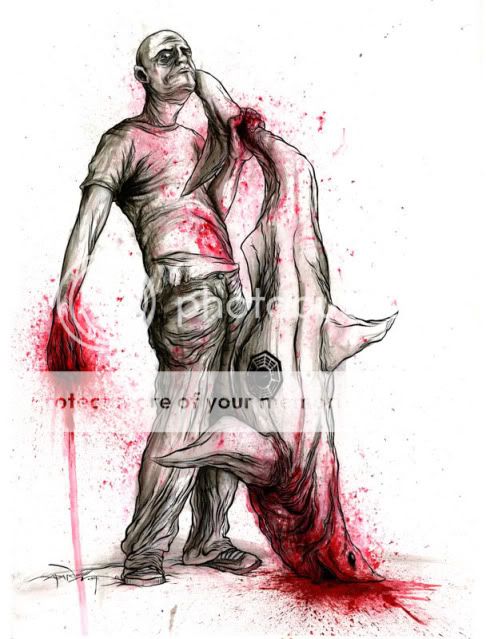
* Now that I’ve finally gotten around to watching it, I agree with everyone who told me how fascinating this BBC roundtable on Joe Sacco’s Footnotes in Gaza is. First of all, I didn’t know Sacco had that accent. Secondly, it’s good to see someone object to Sacco’s standard, subjective, “here’s the side of the story with which I sympathize” take on things without obviously sharing the agenda of the other side. Finally, apparently in the U.K. you can be an elected official and not feel obligated to act stupid and talk at a third-grade level to the people who voted for you. I await a world where American congresspeople use phrases like “filmic immediacy” in a televised discussion of a comic book with the same fervor of Teabaggers anticipating the Rapture. (Via Boots.)
* Chris Evans is Captain America. Okay, sure.
* Nothing really leapt out at me from Whitney Matheson’s weekly plumbing of the Lost commentariat hivemind, but maybe you’ll feel differently. I also recommend taking one last plunge into last week’s Lost thoughts comment thread here at ADDTF before tonight’s goes up.
* For her birthday, I got the Missus tickets to see her favorite choral composer (and mine), Eric Whitacre, conduct a program of his work–e.e. cummings adpatations specifically–at Carnegie Hall in April. So I’m pretty thrilled to see this video of his song “Lux Aurumque,” performed by a “virtual choir” of 185 singers who filmed their separate contributions with their own webcams, go viral. Damn it all, listen to how beautiful this is:
* Beautiful woman on magic horse: Olivia Munn or Alison Goldfrapp–who wore it best?

(Munn on Mike Choi’s unicorn via Heidi MacDonald. Goldfrapp via her own bad self.)
“And as things fell apart, nobody paid much attention”
March 22, 2010Over the past week and a half or so I’ve been reading George R.R. Martin’s A Song of Ice and Fire series, prompted equally by HBO’s greenlighting of a series based on the books and by all the enthusiastic comments about them here on the blog. I’m done with A Game of Thrones (the first volume, which lends its name to the HBO series) and about a third of the way into book two, A Clash of Kings. There’s a little scene in the latter I just loved, and it gives me a chance to talk about a bunch of things I’m really enjoying about the series. SPOILER WARNING duly issued, though I don’t give away a whole lot of potentially enjoyment-lessening stuff, I don’t think.
Anyway, way down South in the capital city of King’s Landing, the book’s anti-hero, an aristocratic little person named Tyrion Lannister who is currently helping to run the kingdom, has his hands full. In addition to helping gird his war-torn kingdom against several major pretenders to the throne and their armies, he’s also navigating the treacherous, occasionally murderous politics of the high-ranking officials within the city itself. He’s got a secret girlfriend, he’s trying to solve a murder mystery for which he himself was once framed, his love-hate relationship with his sister the Queen could go permanently sour at any point, the peasants are revolting (rimshot!), and so on and so forth. For these reasons, and because the messenger in question is a right dickhead, he blows off an emissary from the Wall that guards the farthest border of the kingdom hundreds of miles to the North, and decides to see the severed hand the man has brought along with him (for reasons Tyrion doesn’t even bother to learn) another day. Maybe.
What we know and Tyrion doesn’t is that the last time we saw the severed hand, it was still moving of its own accord. And shortly before that, it was attached to a dead man, who’d risen in the middle of the night to slaughter those he once called his brothers in the Night’s Watch along the Wall.
What makes this such an evocative, powerful little moment? Quite a few things. For starters, the fantasy element in these nominally fantasy books has been minimal. In A Game of Thrones, it’s present in the prologue, then doesn’t reappear until the final few chapters. But that prologue is our first glimpse of the Others (!), a supernatural menace lurking in the wilderness beyond the Wall that turn their victims into undead soldiers for their cause, and so on and so forth. Kind of a Tombs of the Blind Dead deal, if you will. Since this is the very first chapter in a proposed seven-book series, we can assume (and indeed, only 1 1/3 books into the series, that’s all I myself can do) that this will be the crux of the whole affair. But when tipped off to this potentially apocalyptic development, Tyrion Lannister shrugs it off without even realizing the import of what he’s heard. I love the idea of the world’s most important piece of information being lost in the shuffle. It’s like the end of Raiders of the Lost Ark, only if the Ark was secretly multiplying and readying the destruction of civilization there in that warehouse.
So that’s the main thing I dig about it so much. But it also speaks to some of the books’ unique strengths. For example, so much of what happens in them hinges on the personal relationships between the characters, and the way old grudges or old friendships cloud judgement and lead to poor decisions. In this case, the Night’s Watch sent as messenger Ser Alliser Thorne, a man Tyrion had come to dislike during his own visit to the Wall months ago. Tyrion has no problem letting the asshole cool his jets for a few days — the more insulted he gets by the delay, the better, in fact. This despite the fact that Tyrion has been shown to be not just one of the shrewdest characters in the book, but also, despite the crimes of his loathsome family, one of the fairest and most interested in administering justice and preserving the kingdom and its people. What’s more, during his visit to the Wall he took a genuine interest in the fate of the Night’s Watch and promised he’d do what he could to persuade his family to support their mission. But even so, he still can’t help but give the brush-off to a dude who picked on him — and who could blame him?
Another strength: Martin doesn’t hesitate to show that even when a decision is made wisely and justly, with good intentions, and even with good results, that doesn’t mean it can’t still be a disaster in some unforeseen fashion. In this case, it really was a good thing for the head of the Night’s Watch, the Old Bear, to send Ser Alliser away. The guy was a sadistic tool, and in his position as a sort of drill sergeant for new recruits he was much better at bullying his chargers and setting up potentially fatal conflicts between them than he was at actually training them to fight. By sending Thorne on his way, the Old Bear instantly improved the quality of the training the Watch’s desperately needed recruits would receive and punished a creep for his abusive ways. It just happened to backfire in that he didn’t realize Tyrion would be the man to receive the message.
On a structural level, it’s also just a hoot to see one of the book’s many separate storylines poke its head into another. The goings-on at the Wall tied tightly to the main storyline early in book one, with Jon Snow, a member of main character Eddard Stark’s extended family, going to the Wall to join the Watch and Tyrion coming along to pay it a visit. But since then it’s been off on its own almost entirely, with the intrigue and infighting over the kingship and its attendant positions taking precedence. Heck, elsewhere there’s a storyline taking place far outside the kingdom that has yet to tie directly into the main storyline at all, unless you count the decision to dispatch an assassin in the latter bearing fruit in the former, which I don’t since there’s no character overlap. In fact, I read that that storyline won awards on its own as a separate novella — and you really could excise those chapters and have a standalone book if you wanted to. I admire the patience involved, and Martin’s ability to invest his many separate strands with more or less equal pull.
Finally, how creepy is the image of a severed, rotting hand flexing and clutching all on its own as a desperate messenger travels hundreds of miles to a besieged city in a vain attempt to warn its inhabitants that soon such hands could be around their collective throat?
In short, these books are engrossing as all get-out. I’m glad I’m reading them and would recommend you do the same.
Carnival of souls: Special “Not really special, I just like this one” edition
March 22, 2010* Kiel Phegley interviews Mike Mignola at length about Hellboy, B.P.R.D, and the whole Mignola-verse of titles. Best of all, it’s just part one of an ongoing series! I was pleased to see Kiel ask a question of mine, and equally pleased to see a sneak preview of the next issue of B.P.R.D.: King of Fear, aka “the book where all the chickens come home to roost.”
* Recently on Robot 6:
* The promising-looking but unfortunately-on-newsprint anthology pood is set to debut at MoCCA;
* Salon drops Tom the Dancing Bug;
* Is Mark Millar racist and sexist?;
* and Kurt Busiek is on Twitter.
* At this point I could read nothing but Zak Smith’s alphabetical rundown of D&D monsters and still come away from the Internet a happy man. Here’s E (as in Eye, Floating) and here’s F (as in Flail Snail).
* My favorite part of Frank Santoro’s lengthy review of Gipi’s excellent Garage Band is right at the beginning, where he notes that the book’s casual, anecdotal (lack of) narrative is a feature, not a bug. (Personal to Matthew P.: Garage Band is another good “You liked Scott Pilgrim–now what?” book.)
* Art galore–I know you wanna click the links for the full-sized versions, don’t you?:
* Closed Caption Comics has posted a trio of previews of its eponymous anthology’s ninth volume. Mr. Freibert’s back cover Pete Frazon’s front cover is really blowing my mind.

* Joe Kolitsky draws the Wolverine/Conan throw-down of your memories!
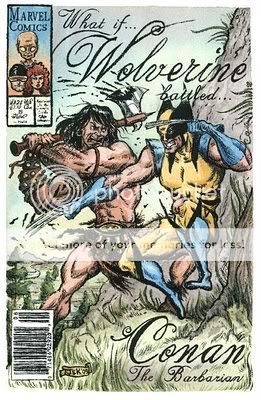
* Tom Neely draws the Glenn Danzig/Henry Rollins romance comic of your dreams!

* Rob Bricken draws the Captain Caveman portrait of your nightmares!

* Calling all bears: Ben Morse salutes Comics’ Finest Beards!
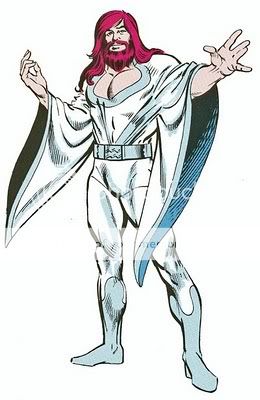
* I stayed away from this for a while because it’s so meme-y, but I finally relented, and it’s every bit as delightful as everyone’s saying: It’s a video of a bunch of Lost cast members saying “Mmmm…cake.” Is there a way to loop the Elizabeth Mitchell/Yunjin Kim portion? (Explanation via Todd VanDerWerff.)
Comics Time: Black Hole
March 22, 2010
Black Hole
Charles Burns, writer/artist
Pantheon, 2005
368 pages
$18.95, softcover
Originally published at The Savage Critics on February 23, 2009.
You lose a lot of extremely impressive supplemental material if you purchase or read only the collected edition of Black Hole rather than the individual issues from Fantagraphics (and, earlier, Kitchen Sink). The full-color front and back covers for each issue are probably what stand out in most people’s minds, followed perhaps by the almost masochistically detailed endpage spreads, and last but not least those terrific ripped-from-the-hotbox dialogue snippets that accompany Burns’s yearbook-portrait openers. I think everyone is probably partial to the one where a guy asks to be cremated if he dies so that his friends can smoke his ashes, but the one from the first issue isn’t some nugget of stoner wisdom, it’s the premise of the entire book:
It was like a horrible game of tag…It took a while, but they finally figured out it was some kind of new disease that only affected teenagers. They called it the “teen plague” or “the bug” and there were all kinds of unpredictable symptoms…For some it wasn’t too bad – a few bumps, maybe an ugly rash…Others turned into monsters or grew new body parts…But the symptoms didn’t matter…Once you were tagged, you were “it” forever.
That quote made it into the collected edition as the back-cover blurb. This one, from the twelfth and final issue, didn’t:
It’s like tryin’ to explain sex to a nun – there’s no way you’d ever understand it unless you lived it. I was there, okay? Half my fuckin’ friends died out there, man. I never dreamed I’d get out of that shit-hole…but one day I notice the stuff on my face is starting to heal and a couple of months later, I’m totally fuckin’ clean…out walking around with all the normal assholes.
This directly contradicts the quote from the first issue and upends the premise it establishes. Turns out the horror of the teen plague is finite. Turns out everything that happened in the book didn’t need to happen, not the way it did, not based on the assumption that nothing was going to change and they’d never get better. Turns out, in other words, that the teen plague was ultimately like being a teenager itself: It sucks, but you grow out of it.
Rereading Black Hole for the fourth time or so, it’s easy to see the set-up for this punchline. Keith in the woods during the kegger where he finds out Chris has the bug, peeing on a tree and grumbling to himself, “This is it…this is all it’s ever gonna be. It’ll never get better…I’ll always be like this…” Chris’s similarly themed rebuke of her parents: “You don’t understand! You’ll never understand! Never!” The constant hyperbole the kids use to describe virtually everything even potentially enjoyable: “It was going to be the best day of my life”; “Rob had brought along all kinds of incredible things to eat…black olives, an avocado, french bred, salami, cheese…”; “All right! That’s gonna blow your fuckin’ mind!“; “It’s called Monument Valley–you won’t believe how amazing it is!”; and my favorite, “I want to show you how to make the best sandwich in the world.” Chris telling Rob “I’ll love you forever, no matter what,” and Keith and Eliza telling each other the same thing. Chris’s repeated refrain “I’d stay here forever if I could”–in Rob’s arms, in the icy water looking up at the night sky. Everything is either the best it can possibly be or the worst it can possibly be, and it will never change.
Needless to say that’s just about the most accurate depiction of the emotional life of teenagers I’ve ever seen. It’s how I remember high school. It’s not terribly far removed from how I remember college. (And to be perfectly honest, when I think of how I look at the world even now, it’s within spitting distance of how I live today, which is probably a big part of why this is one of my favorite comics.) But of course, things do change. Bad things usually get better, which is why it’s such a goddamn tragedy any time a teenager commits suicide because of a bad grade or a breakup–or when a group of sick kids feels it necessary to drop out of school, run away from home, and in the case of some characters literally throw their lives away. And unfortunately, good things often get worse; parents do understand, at least some of the time, and it’s damn hard to tell someone “I’ll love you forever, no matter what” and mean it, and two stoners driving across country probably won’t be able to find a cozy apartment where he can make an honest living and she can work on her art and they both live happily ever after. That’s a tragedy too.
So why remove the quote that points this out, the quote that completes the metaphor? Maybe–and I’m just guessing here; I’ve interviewed Charles Burns about this book a couple of times but I don’t recall asking him about this–he didn’t want to give us that escape valve. Maybe he doesn’t want us to read this and think, “Silly kids, if only they knew.” Maybe he wants to eliminate anything that lessens the number-one effect of the story and the art here: claustrophobia.
Honestly, the claustrophobia of Black Hole is what struck me the most in this reread. Take the panel gutters, for example. Burns employs a traditional method of delineating between real-time action and dreams or flashbacks–straight gutters for the real stuff, wavy gutters for the reveries. But those wavy gutters still create as uniform a grid as ones drawn with a ruler would. Instead of dreaminess, they evoke haziness, like heat waves radiating up from a road or the room spinning when you’re cataclysmically wasted. Indeed, the few times the grids do deviate from the norm is when the characters are completely blotto, or completely panicked–even there, panels remain locked in tiers, and the effect is like careening from one side to another when you’re too drunk to stand up straight and really, really wish you were suddenly sober again but you’re stuck drunk. There’s no way out.
Then there’s the look of the art itself. Elsewhere I’ve described it as like immersing yourself in a blacklight poster, which is apt not just because of the subject matter (look and you’ll see a few such posters on a few walls, in fact) but because looking at this book can practically give you a contact high. While I read the book this time around, I thought it might be neat to listen to a couple of playlists I recently made of the kind of electronic music I listened to in college, a time when presence of the kind of emotions you find in Black Hole still feels fresh to me, a time when I got stoned pretty frequently listening to that very music. Even though I did this on the commuter train out of New York, I’ll be damned if I didn’t feel the pressure on my eyeballs, the weight in my limbs, a slight throbbing of the vision when staring at Burns’s flawless blacks and the trademark shine effect of his characters’ hair. For the first time in his career, I think, style and substance lined up perfectly. It’s not for nothing, though, that the use of drugs and alcohol in the book almost always reduces the options available to the characters–most of the time they prevent people from doing what needs to be done or saying what needs to be said, and even during the story’s few positive depictions of inebriation, intoxicants are used to push things toward a preordained conclusion rather than open up other possibilities. No minds are expanded.
Maybe the most powerful aspect of the book’s claustrophobic effect is its eroticism. True to adolescent love and lust, the desire these characters have to fuck one another is irresistible and all-consuming–it has to be, or else the story couldn’t have happened, and virtually every major plot development wouldn’t have taken place either. Frequently the very environments where the sex takes place contribute to this feeling. Rob and Chris’s fateful liaison takes place in a graveyard. Keith first sees Eliza, nude from the waist down, under the harsh and unforgiving glare of florescent kitchen lights
. He first becomes aroused by her when her tail struggles against the restraint of her towel. Their romance is kindled in her bedroom, surrounded by hundreds of her bizarre (and very blacklight) drawings. They first have sex while stoned as fuck, a red scarf draped over the lamp and bathing everything in crimson. The atmosphere is oppressive, but so can be the feeling of being very, very turned on. “That’s all it took to get me totally sexed up and crazy,” says Keith of his first kiss with Eliza. “I could hardly catch my breath.” (Is it worth noting I knew a girl who looked a bit like Eliza back in college? Probably.)
One final motif comes to mind when I think of how Black Hole works to confine and oppress: repetition. I’ve already mentioned some of the repeated dialogue, and there are any number of repeated visual cues–shattered glass, snakes, holes–and even repeated scenes–Chris floating in the water, those dream sequences. But there are two instances of repetition that stand out to me the most. The first is when Keith angrily leaves his parents’ house to avoid watching some lame TV movie with them, only to end up tripping on acid and watching the very same movie at his friend’s girlfriend’s place. The second, and the most chilling, is Eliza’s sexual assault, which is an implied echo of never-directly-described abuse she suffered at the hands of her stepfather–and, as her nightmare at the end of the book indicates, will likely continue to haunt her dreaming and waking life. Even her and Keith’s blissful roadtrip escape is just a tour of places she’s already been, trying to recapture the happiness she knew long ago. And maybe this more than anything else is why cutting that final reveal that the bug was temporary was the right move: Bad things usually get better, but that doesn’t mean they never come back–different, perhaps, but the same in all the ways that count. Sometimes you can break free of something only to spin right back around to it, spiraling inward into that gravitational maw until that bad thing might as well be constant, for all you can truly escape from it.
I mean, the book is called Black Hole.
For further discussion of Black Hole by myself and Dick Hyacinth, visit The Savage Critics.
Carnival of souls
March 19, 2010* They–and by “They” I mean some of the worst of Them, Michael Bay and Rob Cohen–are going to remake The Monster Squad. Look, I’m not some “raping my childhood” mouthbreather, but the original was good for a variety of reasons specific to itself, from Stan Winston’s creature effects to a script from Shane Black edgy enough to never get off the ground as a children’s movie today, that simply aren’t going to be in play here, so why fucking bother.
* Jeez, I could lose hours reading Zak Smith’s posts about D&D monsters. Twenty-two tagged posts in the series! And he’s now going through them all alphabetically! I want to leisurely drink a beer while I read this. I mean, shit, read this essay on dragons. Got dang.
* Even without ever having read so much as a panel by John Stanley, I can appreciate the geekiness of this “stream of Stanley” from Jeet Heer.
* This post on the overuse of teal-and-orange color grading by Hollywood has been making the rounds so much over the past few days I don’t even remember where I first saw it. I do remember that I first clicked on it because I remembered a weird comment one of the judges made a couple weeks ago on Project Runway, to the effect that the teal-and-orange color scheme of one contestant’s dress was weird and bad. I can see the spine of Jimmy Corrigan: The Smartest Kid on Earth from where I sit when I watch TV, so obviously I disagreed that this was some bizarre violation of the norm. Apparently Hollywood does too. Anyway, like anyone who goes to the movies or watches TV I’ve noticed how nuts everyone’s gotten with the icy blues, but I don’t think I’d noticed the teal component. Eye-opening!
* Finally:
Carnival of souls
March 18, 2010* Is August 2010 shaping up to be the best month for action movies ever? Neil Marshall’s Centurion on August 6th, Edgar Wright’s Scott Pilgrim vs. the World and Sylvester Stallone’s The Expendables on the 13th. Triple feature!
* Frazer Irving leads a Seven Soldiers class reunion on Batman and Robin and The Return of Bruce Wayne. Thus the artist hot streak of Frank Quitely, Cameron Stewart, and Andy Clarke remains unbroken. Wait, what?
* Recently at Robot 6: Wizard relaunches its website and spoils Battlestar Galactica in the process and Kate Beaton does a comic about Lost and does not spoil it in the process.
* An anthology featuring new Ron Rege Jr. and John Hankiewicz? Why did no one tell me of this? Publisher of Shitbeams on the Loose #2, my email’s in the left-hand sidebar.
* Wow, Dave Johnson’s really breaking the Mignolaverse mold for his upcoming Abe Sapien cover run. Also, upcoming Abe Sapien!
* I hope Hercules bedded dudes down all across the Marvel Universe.
* Uncle Steve got a bum steer.
* Real-Life Horror: The Roman Catholic Church is an international child-rape racket whose leaders from the Pope on down all belong on trial at The Hague, parts one and two. Just so you know!
* All mash-ups are equal, but some are more equal than others. This little Matthew Yglesias piece on Michiko Kakutani being hoist by her own anti-quotation-culture petard made me laugh, even though I am broadly sympathetic to some of what I’ve seen from Jaron Lanier (about whom she was talking) when flipping through You Are Not a Gadget, particularly a bit about how the Internet’s built-in anonymity gave rise to a happiness-depleting culture of bullies. I need to get that book.
* Honestly? Even as a kid, I wished the Teenage Mutant Ninja Turtles would do exactly this. Li’l Sean was like “They have bladed weapons!” (Via Topless Robot–where else?)
Happy St. Patrick’s Day!
March 17, 2010Carnival of souls
March 17, 2010* Boardwalk Empire, a new HBO series about Prohibition-era gangsters created by The Sopranos‘ Terence Winter, directed by Martin Scorsese, and starring Steve Buscemi, Leonardo DiCaprio doppelganger Michael Pitt, Omar from The Wire, and whatsername from Trainspotting and No Country for Old Men? I’ll eat it and ask for seconds! (Via Keith Uhlich.)
* Zak Sabbath’s I Hit It with My Axe, the video companion series to his brilliant blog Playing D&D with Porn Stars, has begun!The funny thing about it is that Sasha Grey is my audience-identification character! She’s an RPG newbie being introduced into an ongoing campaign involving more experienced players, which was my exact position during the one D&D campaign I ever played. This should be fun to watch. And as Rob Bricken says, you really need to be reading Playing D&D with Porn Stars. It’s pure gold.
* Typically astute stuff from Todd VanDerWerff in his Lost review/recap for the week. I liked hearing him echo a comment made by our very own Tom Spurgeon in the comments for my Lost thoughts on yesterday’s episode. Go chime in!
* I share Jason Adams’s intense ambivalence about Human Centipede. My situation is that not wanting to watch more than five seconds of something as much as I don’t want to watch more than five seconds of Human Centipede makes me wonder if maybe I need to watch more than five seconds of it.
* This Aaron Renier contribution to Covered is most delightful to this Ewok-lover. As always, click the link and celebrate the full-sized love.
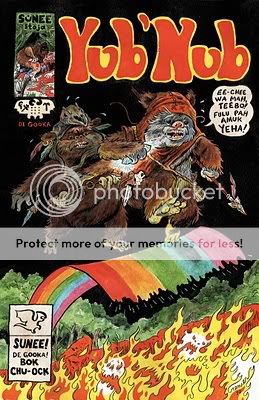
* David Bordwell gently annihilates the notion that film criticism is a dying art. I’m sure you can think of a few comics people who’d be well served to read this essay, right? And music, too, if that’s your thing. Anyway, every boldfaced section header in the piece is a gem, eg. “Writing style is overrated.” I feel like I’m being extra-effusive in this Carnival, but if you care about criticism at all, you need to read this one.
Comics Time: Weird Schmeird #2
March 17, 2010
Weird Schmeird #2
Ryan Cecil Smith, writer/artist
self-published, 2010
32 pages plus six lasercut cardboard toys, plastic sleeve
$8
Ambitiously constructed and beautifully packaged, this is another workout in varying styles by CCC member Ryan Cecil Smith. The cover, and the opening vista of suburbia for the minicomic’s first story “Koshien: Impossible,” scan like Kevin Huizenga. The rest of that first story is all dense, explosive, propulsive ninjas-on-bicycles action, with massive rivers of speedlines that cohere like a Brian Ralph environment. There’s a sketchbook section in the grand “cartoonist’s travelogue” tradition. There’s a story set in the world of Two Eyes of the Beautiful, using that same Umezu-derived style to tell a “they had no idea how close they came to death”-type story about two oblivious, bicurious teenage girls who nearly fall into the clutches of the increasingly demented disfigured woman, who’s already transplanted the brain of one girl’s boyfriend into a dog. There’s a one-page cameo from Noel Friebert, with his trademark graphic treatment of text and almost textual treatment of graphics. There’s a little one-page Anders Nilsen monlogue-type thing. There’s a couple more sketchbook pages, making strong use of tones (as does the whole book). And there’s a third story that starts out with a Dan Zettwoch-style diagrammatic depiction of the university mailroom Smith worked in one summer, before telling the very very average tale of his life at that job in the Porcellino/Huizenga tradition. Finally, there are little die-cut cardboard mock-ups of DHL, UPS, FedEx, and Postal Service vehicles, and even a little mailman. Story #1’s the real highlight here–that thing’s a visual knockout, and I for one am dying to see Smith give that style a longer workout on something other than Xerox paper–but frankly it seems he could have stuck with any one part of this hodgepodge and made a strong minicomic out of it. As it stands, he went with all of them and made a strong minicomic out of that, and he could go down a number of rewarding roads from here.
Lost thoughts
March 16, 2010SPOILERZAPOPPIN
* Explain to me how “We’re takin’ the sub” constitutes a) a cliffhanger; b) an adequate response to their lack of a pilot to fly the plain, unless Sawyer became a sub captain during his Dharma days and I missed it.
* So that part was pretty irritating, and since it’s the end of the episode, it left something of a sour taste in my mouth.
* I suppose I’m also frustrated that my “Widmore’s coming to pick up the MIB” theory didn’t pan out. Well, as far as we know. Everyone is just lying to everyone else all the time now, then admitting it and moving on, so I figure both Fake Locke and Widmore are entitled to be bullshitting about this too.
* Actually, maybe I’m just frustrated by everyone lying all the time. What is this, Gossip Girl?
* Anyway, now that we’ve (in theory) learned that Widmore isn’t on MIB’s side after all, how many factions are really in play over the course of the show? You’ve got Widmore’s people. Ben’s Others. Jacob still seems separate from the Others to me. Then there’s the MIB. The Dharma Initiative. The castaways. Rousseau. The French team?
* In the “pro” column on this week’s installment: Sawyer’s a character who can really hold an episode, and while I’m sure the cop stuff in the flashsideways is as egregious inaccurate as was the teacher stuff in the Ben flashsideways last week, I’m not married to a cop and wasn’t raised by a cop so it didn’t bother me, and instead made a lot of sense as a road Sawyer–or more accurately, in this case, Jim Ford–could have gone down. It makes at least as much sense to become a cop and track down the con man who destroyed your family as it does to become a con man yourself to do it.
* And again we see a character confronting and surmounting the emotional issues that bedeviled them in the original timeline. Jack puts his daddy issues to rest and mends fences with his own son; Locke lets go of his rage and compulsion to prove everyone wrong and allows himself a happy life with his wife-to-be; Sawyer opens up, trusts someone, and knowingly puts a huge if not insurmountable roadblock in the way of pursuing his grudge to its murderous end. In all three cases these aren’t storybook happy endings, but in the immortal words of Bruce Wayne, “This would be a good life…good enough.”
* On the other hand, we’d previously put Kate in this category–instead of running, she came back to care for Claire–but of course here she’s still running. And ending up in the hands of Sawyer/Ford in a fashion reminiscent of Sayid finding Jin.
* Which raises the question: Why the hell did Sawyer, a cop, let a woman in handcuffs go at the airport in the first place? Was it because he didn’t want to reveal to anyone that he was there? Wouldn’t there be ways to tip someone off without saying “I’m a cop”–like not helping her sneak past security, for example? Well, maybe this’ll come out during her interrogation, I don’t know.
* Lots of cameos in this episode. Good to see Charlie’s brother.
* Good to see Charlotte, too! She was never my favorite, but I liked her here, and not just because she looked better than she’d ever looked before. Well, okay, maybe because she looked better than she’d ever looked before. But kudos to Rebecca Mader for that anyway. She was convincingly sexy, and she handled the infuriating humiliation of being angrily booted from a bedroom just minutes after having sex convincingly too.
* (Speaking of which, this is only relevant to Tri-State Area viewers, but one of the things I’ll miss about Lost are those little five second glimpses of Liz Cho during the teaser commercial for Eyewitness News.)
* I don’t know if this says more about Lost or what watching Lost does to people, but Fake Locke tells Sawyer he’s the smoke monster, Sawyer asks about why he killed all those people but not a peep about “what the fuck are you, smoke monster???”, and I barely even blinked.
* Haha, the “I’m just a scared and lonely survivor please don’t hurt me” routine’s been done before, Zoe, and by a better actor than you. Won’t get fooled again!
* Even though it was (too) quickly defused, the creepiness of Claire being all friendsy with Kate and then trying to cut her throat while Sayid looked on all sedated-like, then Fake Locke coldcocking Claire to talk her down, was really somethin’. I wasn’t sure what kind of mileage they’d get out of these sorts of scenes, but it worked, not least because crying is something Evangeline Lilly does well.
Carnival of souls
March 16, 2010* “Why won’t you play the game?” Your very-much-lead item today is Scott Woods’s “In Search of Digital Love,” an hour-long audio documentary/review/essay/mixtape/mash-up/sound collage/whatever exploring Daft Punk’s flawless song “Digital Love.” Aided and abetted by critics Brian MacDonald, Michaelangelo Matos, and Nate Patrin, Woods makes some really astonishing sonic connections here, sometimes by simplly riffing off a single word uttered by his interview subjects–a suite of samples from ’70s/’80s songs with the word “Magic” in the title, for example. (This makes me want to make a playlist of such songs, but adding in my twin faves from this ’80s-radio-staple subgenre, the Alan Parsons Project’s “Magic” and Steve Miller’s “Abracadabra.”) Meanwhile, I never would have thought of “Layla,” but dang if that isn’t dead on. And there’s science-fiction content galore in there, as you also might expect. (I’m proud I recognized Lenny Van Dohlen’s voice in the commercial for Electric Dreams simply from remembering him as Harold in Twin Peaks–which is also sampled!) I’m so impressed by this thing it’s not even funny. Take the time and listen to it. (Via Tom Ewing.)
* Recently at Robot 6: How to write comics and Lady Gaga/Beyonce/”Telephone” tribute art.

* In a very fine postcript to Not Coming to a Theater Near You’s Kubrick retrospective, Aaron Cutler talks about Steven Spielberg’s A.I., lingering on the heartbreak of it. I need to revisit this film.
* Tom Spurgeon reviews the John Porcellino King-Cat collection Map of My Heart. I like when Tom discusses what new things he gets out of experiencing a familiar, even beloved work in a new format, and this review is of a piece with his earlier commentary on Fantagraphics’ excellent Love & Rockets digests.
* Always love a Jeffrey Brown superhero piece.

* Eve Tushnet liked Deadgirl, the hot-zombie-woman-as-sex-slave movie. I’m glad to hear it’s about misogyny rather than a function of misogyny. On the other hand, my wife’s admonishment that we’ve had quite enough art told from the perspective of misogynists, thank you very much, continues to haunt me.
* Apparently They’re very happy with the performance of Caprica and want to make more Battlestar Galactica spin-offs.
* Speaking of: I am very late to this game, but I know you gonna dig Katamaran’s mash-up of Battlestar Galactica with the feel of Spike Jonze’s video for the Beastie Boys’ “Sabotage.” This thing had me laughing out loud, hard, on the train.
I suppose it’s worth pointing out that you could never do this with Caprica. (Via Topless Robot.)
* Twilight Saga: New Moon RiffTrax available simultaneously with the DVD release! BALLS OUT. (Also via Topless Robot, bless his heart.)
* Finally, I took one last dip into last week’s Lost thoughts comment thread. Take a look, then I’ll see you back here tonight!





